Discover 50 hidden attractions, cool sights, and unusual things to do in China. Don't miss out on these must-see attractions: Forbidden City (Beijing), Nathan Road (Hong Kong) or Summer Palace (Beijing).
Below, you can find the list of the most amazing places you should visit in China.
Table of Contents
Forbidden City, Beijing

Also known as: 故宫
Tourist attraction in Beijing, China. The Forbidden City is a palace complex in Dongcheng District, Beijing, China, at the center of the Imperial City of Beijing. It is surrounded by numerous opulent imperial gardens and temples including the 22-hectare Zhongshan Park, the sacrificial Imperial Ancestral Temple, the 69-hectare Beihai Park, and the 23-hectare Jingshan Park.
The Forbidden City was constructed from 1406 to 1420, and was the former Chinese imperial palace and winter residence of the Emperor of China from the Ming dynasty (since the Yongle Emperor) to the end of the Qing dynasty, between 1420 and 1924. The Forbidden City served as the home of Chinese emperors and their households and was the ceremonial and political center of the Chinese government for over 500 years. Since 1925, the Forbidden City has been under the charge of the Palace Museum, whose extensive collection of artwork and artifacts were built upon the imperial collections of the Ming and Qing dynasties. The Forbidden City was declared a World Heritage Site in 1987.
The complex consists of 980 buildings, encompassing 8,886 rooms and covering 720,000 square metres (72 hectares)/178 acres. The palace exemplifies the opulence of the residences of the Chinese emperor and the traditional Chinese palatial architecture, and has influenced cultural and architectural developments in East Asia and elsewhere. It is listed by UNESCO as the largest collection of preserved ancient wooden structures in the world. Since 2012, the Forbidden City has seen an average of 14 million visitors annually, and received more than 19 million visitors in 2019. In 2018, the Forbidden City's market value was estimated at US$70 billion, making it both the world's most valuable palace and the most valuable piece of real estate anywhere in the world.
Some sources describe it as the largest palace in the world still in existence, but other Chinese imperial residences far exceed it in size, namely the 6.1 km2 (610 ha) Zhongnanhai which lies just west of the Forbidden City, the 2.9 km2 (290 ha) Summer Palace in Haidian District, Beijing, and the 5.6 km2 (560 ha) Chengde Mountain Resort in Chengde, Hebei Province.
The Forbidden City in Beijing is one of the largest and most well-preserved ancient wooden structures in the world. It was listed as the first batch of national key cultural relics in 1961 and listed as a world cultural heritage in 1987.[1]
Address: 4 Jingshan Front St, 100021 Dongcheng Qu (东城区)
Nathan Road, Hong Kong
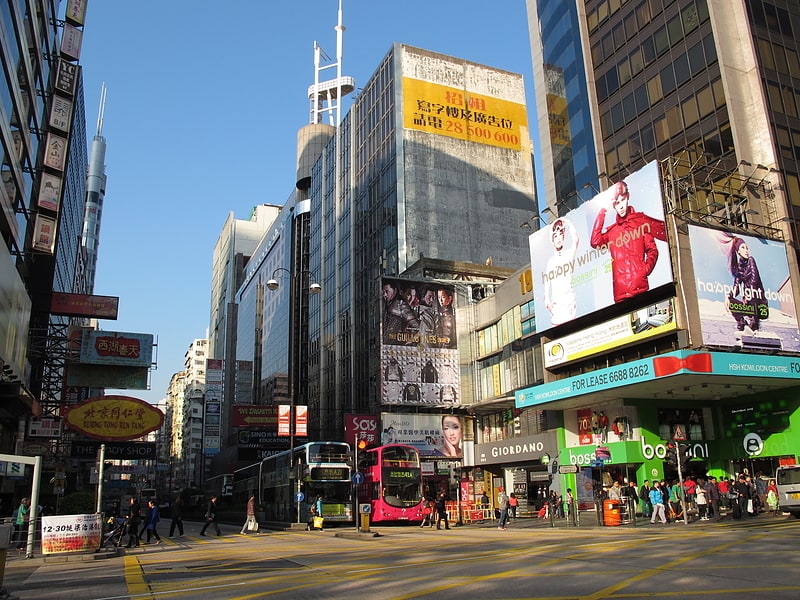
Also known as: 彌敦道
Thoroughfare in Hong Kong, Asia. Nathan Road is the main thoroughfare in Kowloon, Hong Kong, aligned south–north from Tsim Sha Tsui to Sham Shui Po. It is lined with shops and restaurants and throngs with visitors, and was known in the post–World War II years as the Golden Mile, a name that is now rarely used. It starts on the southern part of Kowloon at its junction with Salisbury Road, a few metres north of Victoria Harbour, and ends at its intersection with Boundary Street in the north. Portions of the Kwun Tong and Tsuen Wan lines run underneath Nathan Road. The total length of Nathan Road is about 3.6 kilometres.[2]
Address: 473-473A Nathan Rd., Hong Kong (油尖旺区)
Summer Palace, Beijing
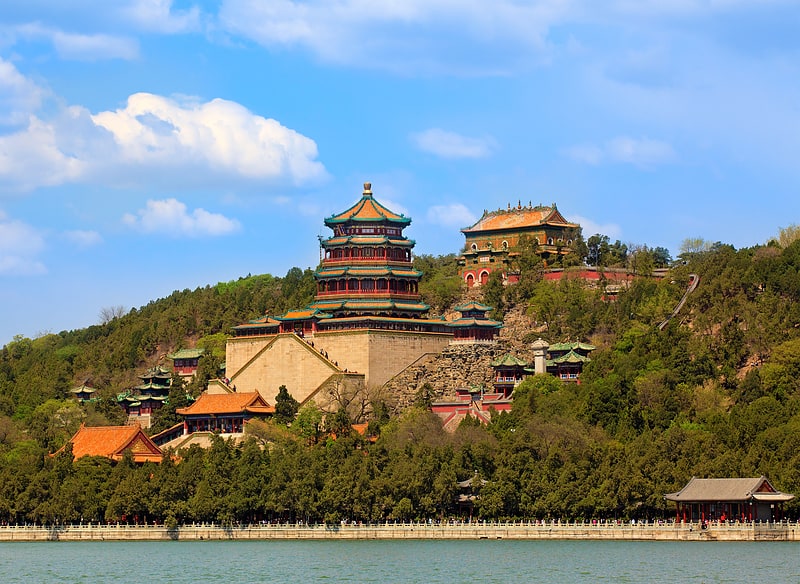
Also known as: 颐和园
Iconic lakeside retreat for royalty. The Summer Palace is a vast ensemble of lakes, gardens and palaces in Beijing. It was an imperial garden in the Qing dynasty. Inside includes Longevity Hill Kunming Lake and Seventeen Hole Bridge. It covers an expanse of 2.9 square kilometres, three-quarters of which is water.
Longevity Hill is about 60 metres (200 ft) high and has many buildings positioned in sequence. The front hill is rich with splendid halls and pavilions, while the back hill, in sharp contrast, is quiet with natural beauty. The central Kunming Lake, covering 2.2 square kilometres (540 acres), was entirely man-made and the excavated soil was used to build Longevity Hill.
Inspired by the gardens in South China, in the Summer Palace there are over 3,000 various Chinese ancient buildings that house a collection of over 40,000 kinds of valuable historical relics from each dynasty.
In December 1998, UNESCO included the Summer Palace on its World Heritage List. It declared the Summer Palace "a masterpiece of Chinese landscape garden design. The natural landscape of hills and open water is combined with artificial features such as pavilions, halls, palaces, temples and bridges to form a harmonious ensemble of outstanding aesthetic value".
Notably in Chinese history, it is also the Central Route terminus of the South-North Water Transfer Project having traversed 1,267 km (787 mi) from Danjiangkou Reservoir, Hubei, making it Beijing's main water supply.[3]
Address: Beiqing Rd, 100091 北京市 (海淀区)
Temple of Heaven, Beijing

Also known as: 天坛
Famed and historic temple complex. The Temple of Heaven is an imperial complex of religious buildings situated in the southeastern part of central Beijing. The complex was visited by the Emperors of the Ming and Qing dynasties for annual ceremonies of prayer to Heaven for a good harvest. The Temple of Heaven was inscribed as a World Heritage site in 1998 and was described as "a masterpiece of architecture and landscape design which simply and graphically illustrates a cosmogony of great importance for the evolution of one of the world's great civilizations..." as the "symbolic layout and design of the Temple of Heaven had a profound influence on architecture and planning in the Far East over many centuries."[4]
Address: Tiantan N Rd | 天坛东里甲1号, 100050 北京市 (崇文区曲)
Shanghai Museum, Shanghai
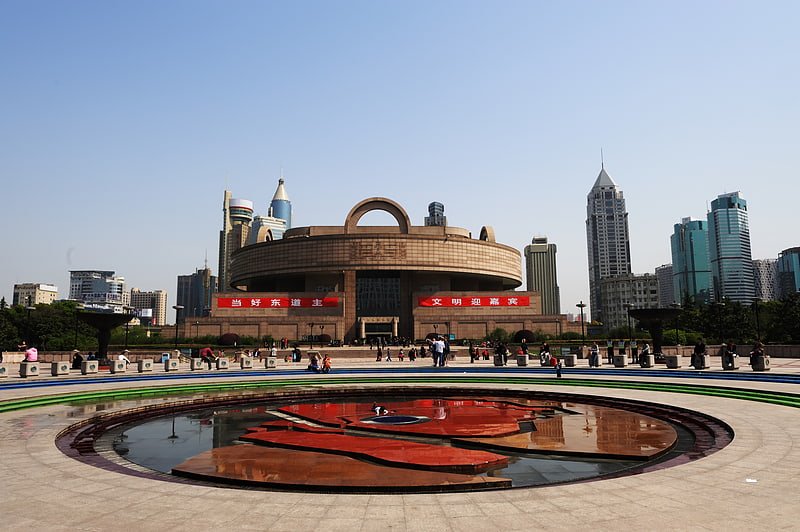
Also known as: 上海博物馆
Museum in Shanghai, China. The Shanghai Museum is a museum of ancient Chinese art, situated on the People's Square in the Huangpu District of Shanghai, China. Rebuilt at its current location in 1996, it is considered one of China's first world-class modern museums.[5]
Address: 201 Renmin Ave, 200003 Huangpu (黄埔)
Hong Kong Science Museum, Hong Kong
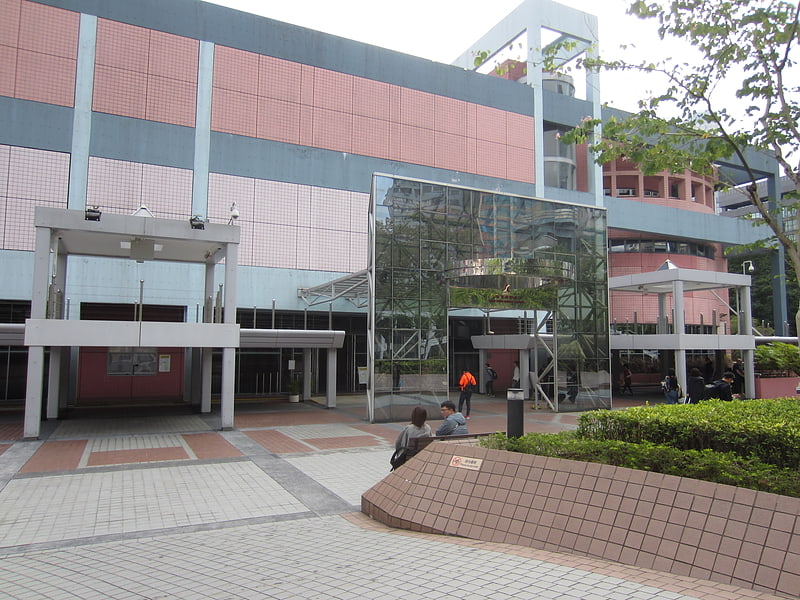
Also known as: 香港科學館
Museum in Hong Kong. The Hong Kong Science Museum is a science museum in Tsim Sha Tsui East, Kowloon, Hong Kong, located next to the Hong Kong Museum of History.[6]
Address: No.2 Science Museum Road, Tsim Sha Tsui East, Kowloon, Hong Kong (油尖旺区)
The Big Buddha, Hong Kong

Also known as: 天坛大佛
Landmark hilltop statue of Buddha. The Big Buddha is a large bronze statue of Buddha, completed in 1993, and located at Ngong Ping, Lantau Island, in Hong Kong. The statue is sited near Po Lin Monastery and symbolises the harmonious relationship between man and nature, people and faith. It is a major centre of Buddhism in Hong Kong, and is also a tourist attraction.[7]
Address: Ngong Ping Rd, Hong Kong (离岛区)
Shanghai Urban Planning Exhibition Center, Shanghai
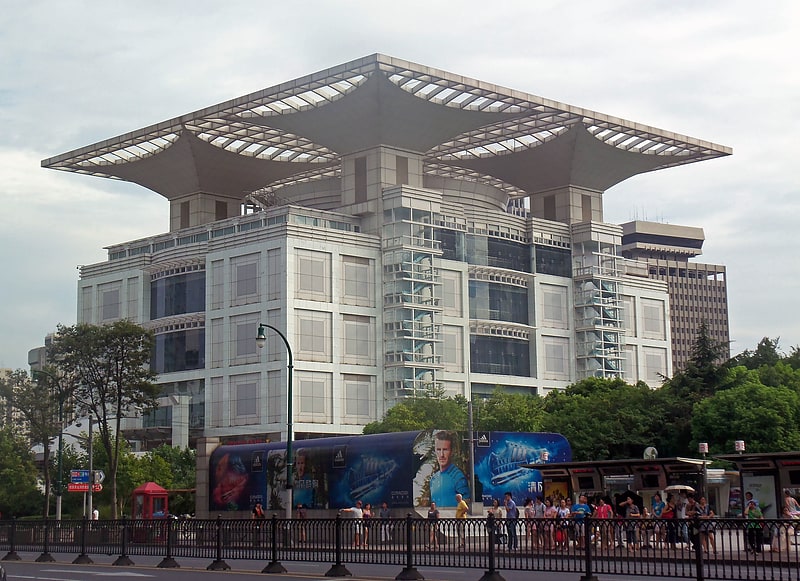
Also known as: 上海城市规划展示馆
Venue for urban-development exhibits. The Shanghai Urban Planning Exhibition Center is located on People's Square, Shanghai, adjacent to the municipal government building.
The Exhibition Center is a six-story building, with two basement levels, which displays Shanghai's urban planning and development. The focus of the exhibit is a large scale model of the entirety of urban Shanghai, showing existing buildings and approved future buildings. Other exhibits relate to Shanghai's history and planned development, including smaller scaled models focussing on particular areas of interest such as the Bund. The Exhibition Center also has space for temporary exhibitions with a wide range of subject matter.[8]
Address: 100 Renmin Ave, 200051 Huangpu Qu (黄埔)
Oriental Pearl Tower, Shanghai
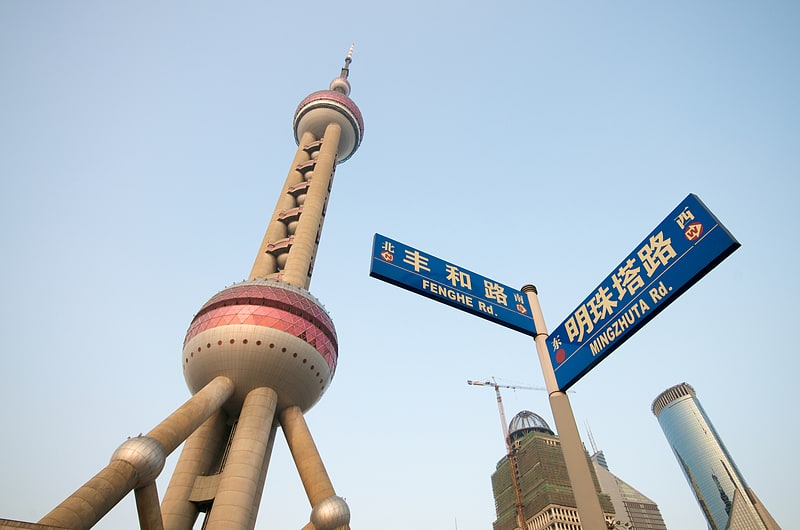
Also known as: 东方明珠广播电视塔
Iconic tower with city views. The Oriental Pearl Radio & Television Tower is a TV tower in Shanghai. Its location at the tip of Lujiazui in the Pudong New Area by the side of Huangpu River, opposite The Bund, makes it a distinct landmark in the area. Its principal designers were Jiang Huan Chen, Lin Benlin, and Zhang Xiulin. Construction began in 1991, and the tower was completed in 1994.
At 468 m (1,536 feet) high, it was the tallest structure in China from 1994–2007, when it was surpassed by the Shanghai World Financial Center. It is classified as an AAAAA scenic area by the China National Tourism Administration. The tower is brightly lit in different LED sequences at night. On 7 July 2007, Oriental Pearl Tower was host to the Chinese Live Earth concert.
The tower features 11 spheres, big and small. The two largest spheres, along the length of the tower, have diameters of 50 m (164 ft) for the lower and 45 m (148 ft) for the upper. They are linked by three columns, each 9 m (30 ft) in diameter. The highest sphere is 14 m (46 ft) in diameter.
In 1995, the Oriental Pearl TV Tower was rated as one of the top ten new landscapes in Shanghai. In 1999, the Oriental Pearl TV Tower won the first prize of Shanghai Excellent Survey and Design Award and the Zhan Tianyou Award of China Civil Engineering. On May 8, 2007, the Oriental Pearl TV Tower was approved by the National Tourism Administration as a national AAAAA-level tourist attraction.
The entire tower is supported by three enormous columns that start underground.[9]
Address: 1 Century Ave, 200088 Pudong Xinqu (浦东)
Macau Fisherman's Wharf, Macau
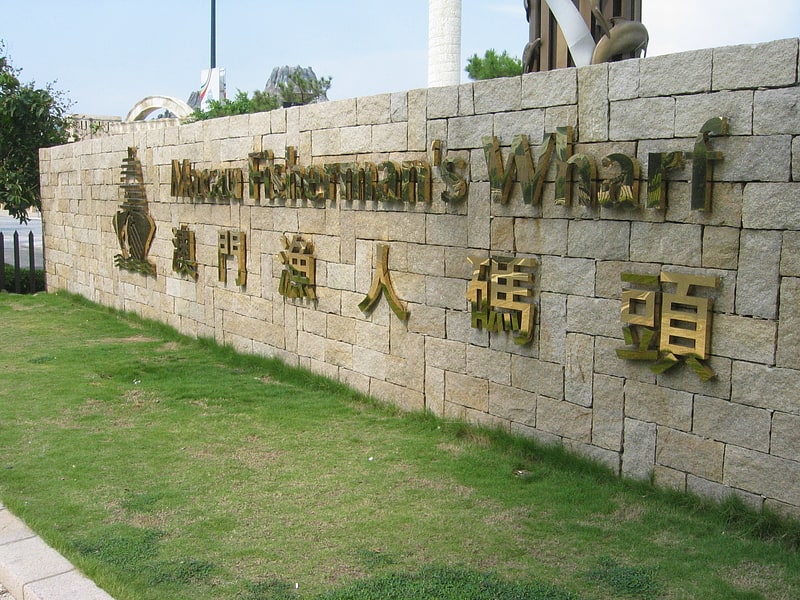
Also known as: 澳門漁人碼頭
Theme park and shopping complex. The Macau Fisherman's Wharf is an integrated waterfront, hotel, convention, dining, retail and entertainment complex in Sé, Macau, China.[10]
Address: Outer Harbor, Macau
West Lake, Hangzhou
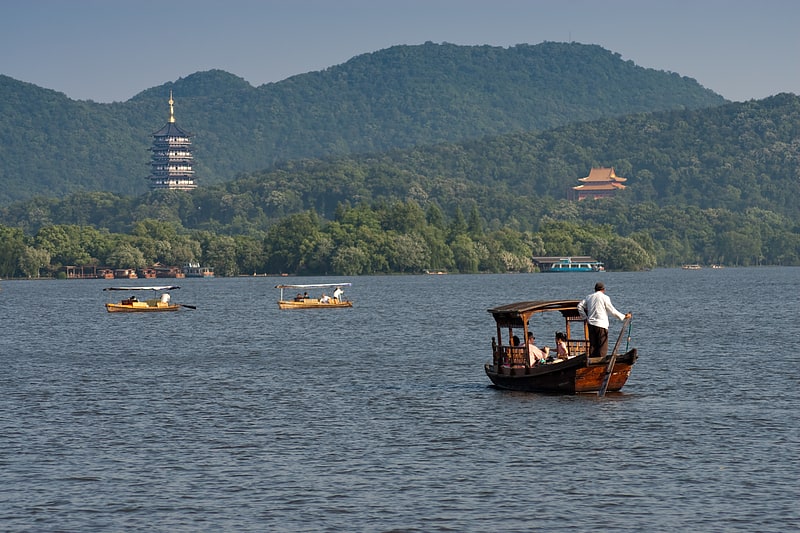
Also known as: 西湖
Lake in China. West Lake is a freshwater lake in Hangzhou, China. It is divided into five sections by three causeways. There are numerous temples, pagodas, gardens, and natural/artificial islands within the lake. Gushan is the largest natural island and three artificial islands: Xiaoyingzhou, Huixin Pavilion, and Ruan Gongdun stand at the middle of the lake. Leifeng Pagoda and Baochu Pagoda are separated by the lake. Mirroring each other, the basic pattern of "one mountain, two towers, three islands, three banks, and five lakes" is formed.
West Lake is located at No. 1 Longjing Road, Xihu District, Hangzhou City, Zhejiang Province, in the west of Hangzhou City. The total area of the scenic spot is 49 square kilometers, the catchment area is 21.22 square kilometers, and the lake area is 6.38 square kilometers.
West Lake has influenced poets and painters throughout Chinese history for its natural beauty and historic relics, and it has also been among the most important sources of inspiration for Chinese garden designers. It was made a UNESCO World Heritage Site in 2011, described as having "influenced garden design in the rest of China as well as Japan and Korea over the centuries" and reflecting "an idealized fusion between humans and nature".[11]
Macau Tower, Macau
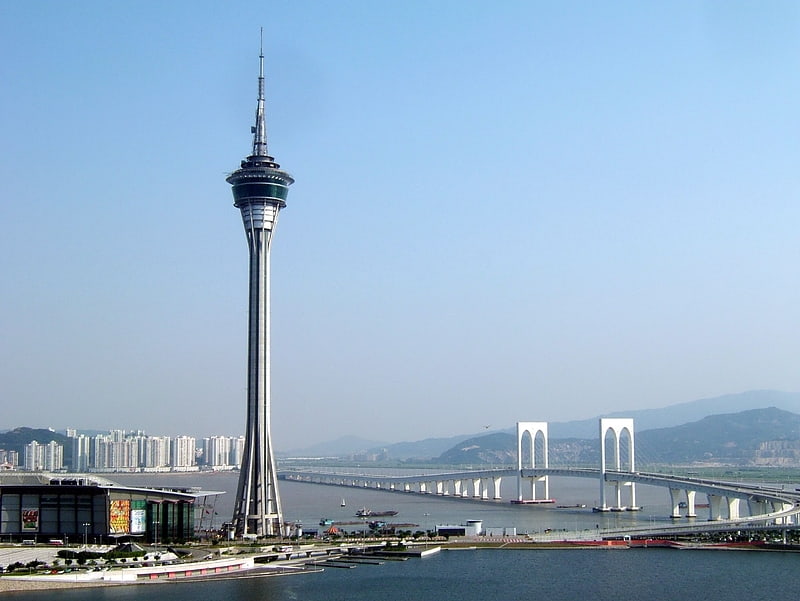
Also known as: 澳門旅遊塔會展娛樂中心
Tower with a revolving restaurant and more. The Macau Tower Convention and Entertainment Center, also known as Macau Tower, is a tower located in Sé, Macau. The tower measures 338 m in height from ground level to the highest point. Its observation deck features views, restaurants, theaters, shopping malls and the Skywalk X, a walking tour around the outer rim. It offers the best view of Macau and in recent years has been used for a variety of adventurous activities. At 233 meters, the Macau Tower's tethered "skyjump" and Bungee jump by AJ Hackett from the tower's outer rim, is the highest commercial skyjump in the world, and is also the second highest commercial decelerator descent facility in the world, after Vegas' Stratosphere skyjump at 252 meters.
The tower was created by Moller Architects and is one of the members of the World Federation of Great Towers. In addition to observation and entertainment, the tower is also used for telecommunications and broadcasting. It and the Grand Lisboa hotel are the most recognizable landmarks of the Macau skyline.[12]
Address: South Bay New Reclamation Area, Macau
Ruins of St. Paul's, Macau

Also known as: 大三巴牌坊
Iconic church facade and religious museum. The Ruins of Saint Paul's are the ruins of a 17th-century Catholic religious complex in Santo António, Macau, China. They include what was originally St. Paul's College and the Church of St. Paul also known as "Mater Dei", a 17th-century Portuguese church dedicated to Saint Paul the Apostle. Today, the ruins are one of Macau's best known landmarks and one of the Seven Wonders of Portuguese Origin in the World. In 2005, they were officially listed as part of the Historic Centre of Macau, a UNESCO World Heritage Site.[13]
Address: Rua de Sao Paulo, Macau
Potala Palace, Lhasa
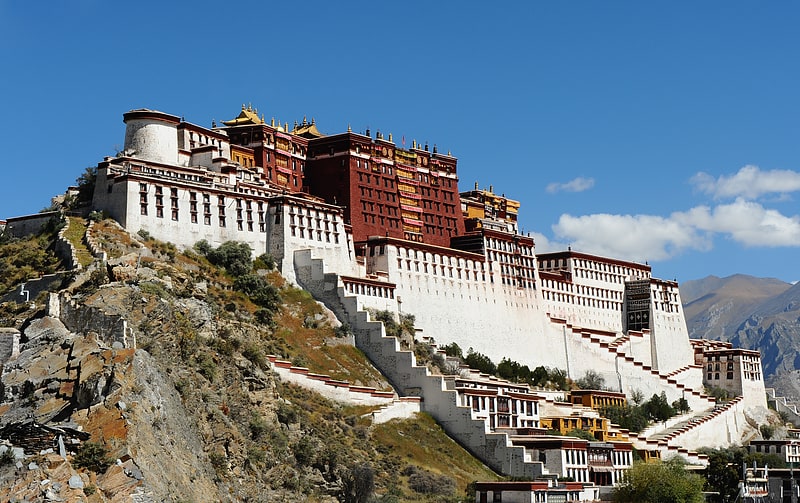
Also known as: 布达拉宫
Famed royal retreat from 17th century. The Potala Palace is a dzong fortress in the Lhasa, Tibet, China. It was the winter palace of the Dalai Lamas from 1649 to 1959, has been a museum since then, and has been a World Heritage Site since 1994.
The palace is named after Mount Potalaka, the mythical abode of the bodhisattva Avalokiteśvara. The 5th Dalai Lama started its construction in 1645 after one of his spiritual advisers, Konchog Chophel (died 1646), pointed out that the site was ideal as a seat of government, situated as it is between Drepung and Sera monasteries and the old city of Lhasa. It may overlay the remains of an earlier fortress called the White or Red Palace on the site, built by Songtsen Gampo in 637.
The building measures 400 metres (1,300 ft) east-west and 350 metres (1,150 ft) north-south, with sloping stone walls averaging 3 metres (9.8 ft) thick, and 5 metres (16 ft) thick at the base, and with copper poured into the foundations to help proof it against earthquakes. Thirteen storeys of buildings, containing over 1,000 rooms, 10,000 shrines and about 200,000 statues, soar 117 metres (384 ft) on top of Marpo Ri, the "Red Hill", rising more than 300 metres (980 ft) in total above the valley floor.
Tradition has it that the three main hills of Lhasa represent the "Three Protectors of Tibet". Chokpori, just to the south of the Potala, is the soul-mountain (Wylie: bla ri) of Vajrapani, Pongwari that of Manjusri, and Marpori, the hill on which the Potala stands, represents Avalokiteśvara.[14]
Address: 35 Beijing M. Rd., Lhasa
Drum Tower of Xi'an, Xi'an
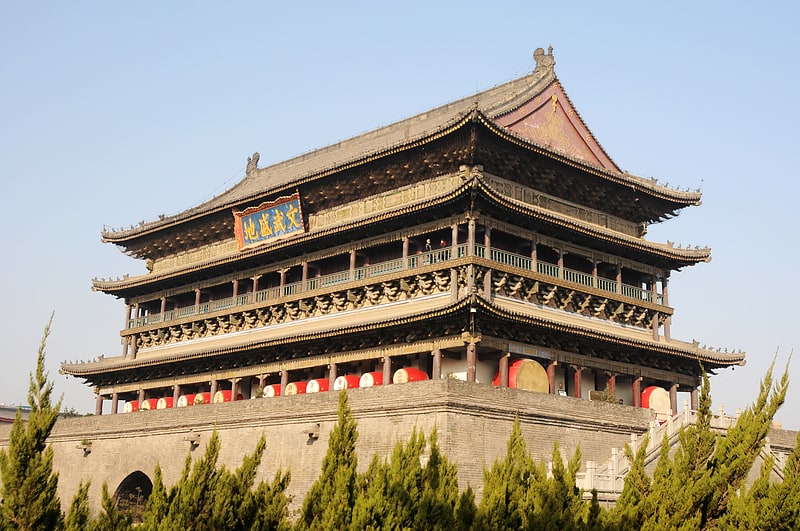
Also known as: 西安鼓楼
Tower in Xi'an, China. The Drum Tower of Xi'an, located in the heart of Xi'an, the capital of Shaanxi province, Northwestern China, along with the Bell Tower is a symbol of the city. Erected in 1380 during the early Ming Dynasty, it stands towering above the city center and offers incredible view of Xi'an.
The Drum Tower got its name from the huge drum located within the building. In contrast to the Bell Tower, where the bell was stricken at dawn, the drum was beaten at sunset to indicate the end of the day.
On the Drum Tower's first floor, lies a hall in which hang many large drums. Each is decorated with intrinsic and beautiful Chinese writing, which symbolises good fortune. The impressive arrays of drums are only on show and visitors are not allowed to touch any of them. But there is an extra drum near the front entrance where visitors can pose for pictures for a small fee.
Inside the Drum Tower there is also a drum museum, where a variety of drums are on display, some of which can be dated back thousands of years. There is a drum show performed here every day. The top of the tower commands a panoramic view of the city.[15]
Giant Wild Goose Pagoda, Xi'an
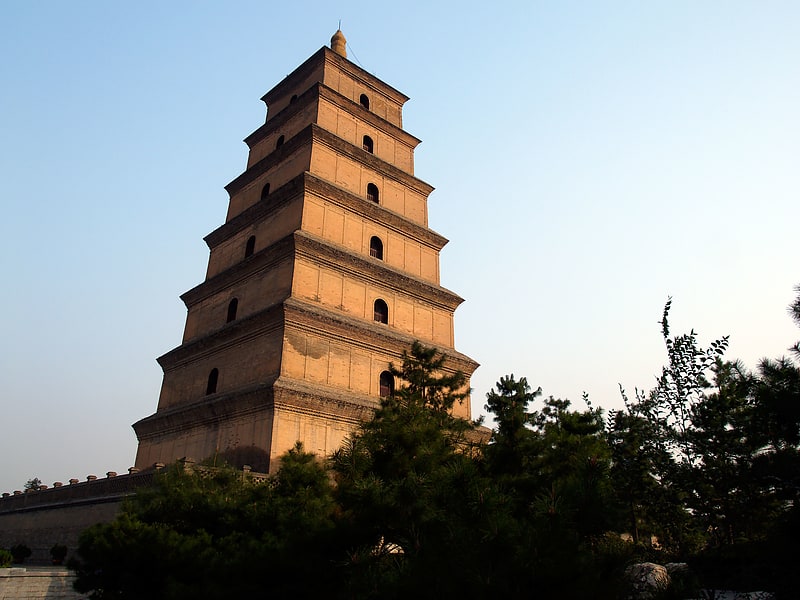
Also known as: 大雁塔
7th-century Buddhist landmark. Giant Wild Goose Pagoda or Big Wild Goose Pagoda, is a monumental Buddhist pagoda located in southern Xi'an, Shaanxi, China. It was built in 648/649 during the Tang dynasty and originally had five stories. It was rebuilt in 704 during the reign of Empress Wu Zetian and its exterior brick facade was renovated during the Ming dynasty.
One of the pagoda's many functions was to hold sutras and figurines of Gautama Buddha that were brought to China from India by the seventh-century Buddhist monk, scholar, traveller, and translator Xuanzang. Today, the interior walls of the pagoda feature engraved statues of Buddha by the renowned 7th-century artist Yan Liben.
This pagoda was added to the so-called World Heritage List, along with many other sites along the Silk Road, as part of the "Silk Roads: the Routes Network of Chang'an-Tianshan Corridor" site in 2014.[16]
Presidential Palace, Nanjing
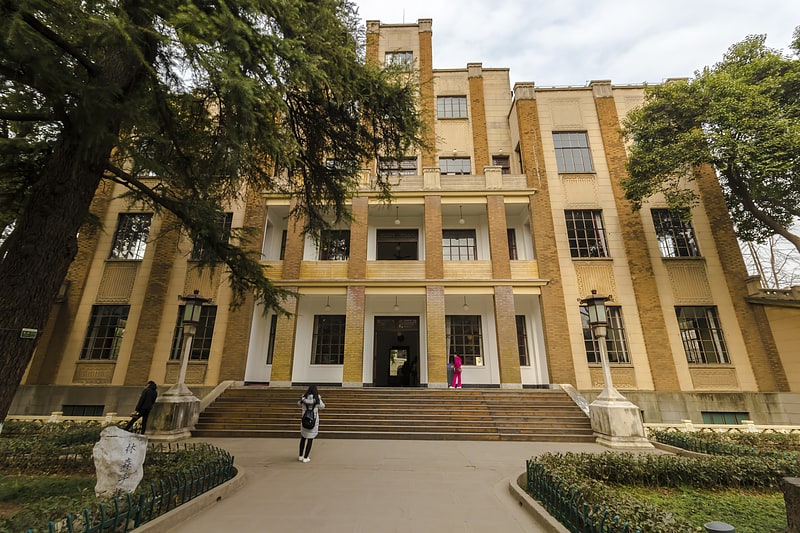
Also known as: 南京总统府
Baroque presidential office building. The Presidential Palace in Nanjing, Jiangsu, China, housed the Office of the President of the Republic of China since 1927 until the capital was relocated to Taipei in 1949. It is now a museum called the China Modern History Museum. It is located at No.292 Changjiang Road, in the Xuanwu District of Nanjing.[17]
Address: 292 Changjiang Rd, 210089 Nanjing Shi
Great Mosque of Xi'an, Xi'an
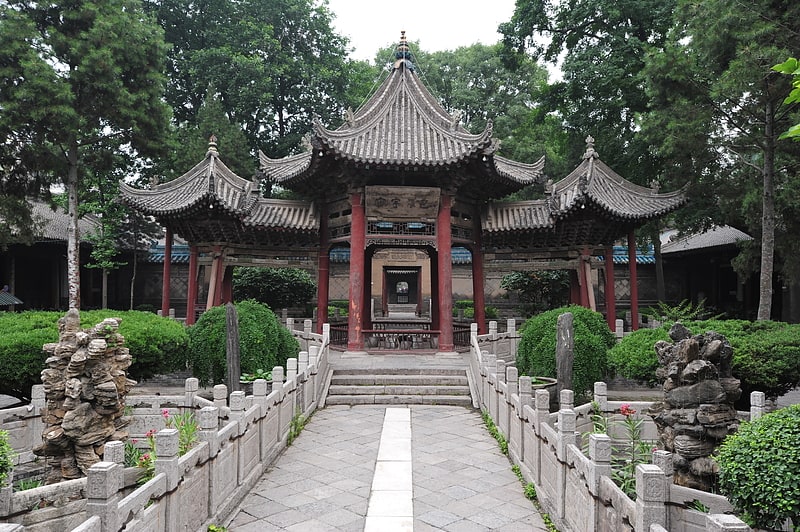
Also known as: 西安大清真寺
Expansive Tang dynasty mosque. The Great Mosque of Xi'an is one of the largest premodern mosques in China. Although the mosque was allegedly first built in the year 742 AD, its current form was largely constructed in 1384 AD during Emperor Hongwu's reign of the Ming dynasty, as recorded by the Records of Xi'an Municipality.
An active place of worship within Xi'an Muslim Quarter, this courtyard complex is also a popular tourist site. It now houses more than twenty buildings in its five courtyards, and covers 12 km² (4.63 mi²).[18]
Address: Huajue Alley, 710001 Xian Shi
Ming Xiaoling Mausoleum, Nanjing
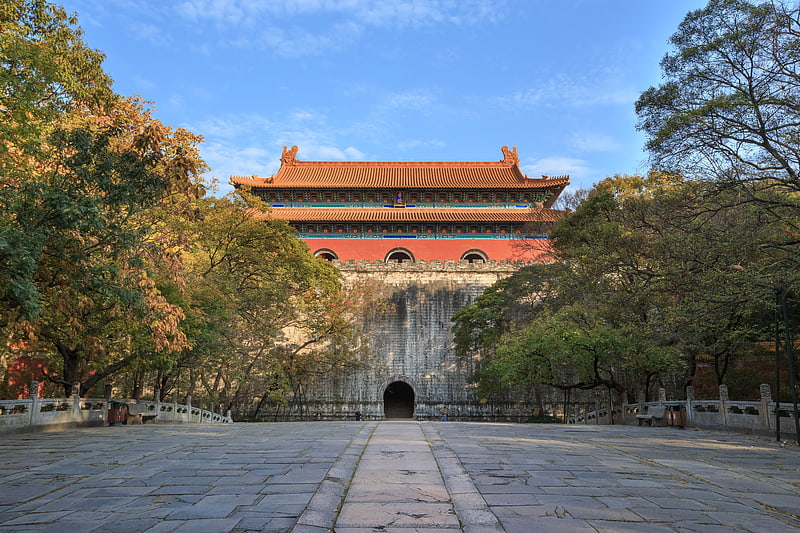
Also known as: 明孝陵
Ming Dynasty tomb with many statues. The Ming Xiaoling is the mausoleum of the Hongwu Emperor, the founder of the Ming dynasty. It lies at the southern foot of Purple Mountain, located east of the historical centre of Nanjing. Legend says that in order to prevent robbery of the tomb, 13 identical processions of funeral troops started from 13 city gates to obscure the real burying site.
The construction of the mausoleum began during the Hongwu Emperor's life in 1381 and ended in 1405, during the reign of his son the Yongle Emperor, with a huge expenditure of resources involving 100,000 labourers. The original wall of the mausoleum was more than 22.5 kilometres long. The mausoleum was built under heavy guard of 5,000 troops.[19]
Humble Administrator's Garden, Suzhou
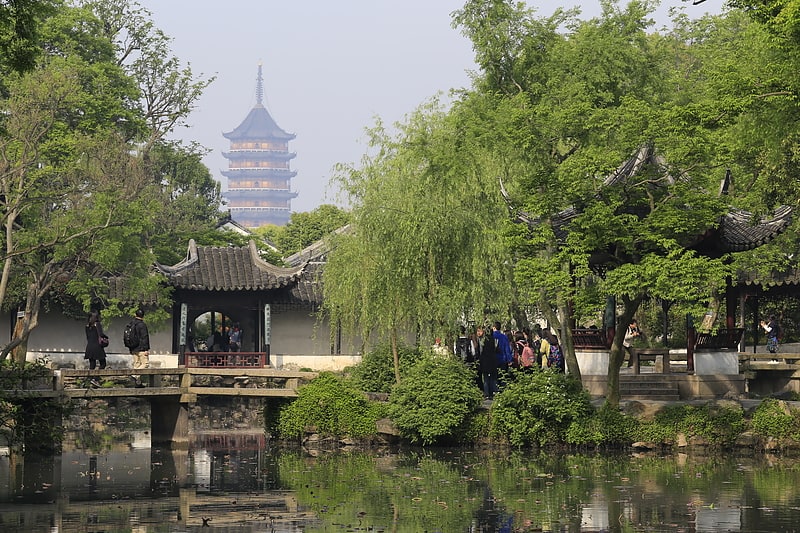
Also known as: 拙政园
Ming-era garden with 3 individual areas. The Humble Administrator's Garden is a Chinese garden in Suzhou, a UNESCO World Heritage Site and one of the most famous of the gardens of Suzhou. The garden is located at 178 Northeast Street, Gusu District. At 78 mu, it is the largest garden in Suzhou and is considered by some to be the finest garden in all of southern China.[20]
Address: 178 Dongbei St, 215001 Suzhou Shi
Jokhang Temple, Lhasa

Also known as: 大昭寺
Buddhist temple with a hallowed shrine. The Jokhang, also known as the Qoikang Monastery, Jokang, Jokhang Temple, Jokhang Monastery and Zuglagkang, is a Buddhist temple in Barkhor Square in Lhasa, the capital city of Tibet Autonomous Region of China. Tibetans, in general, consider this temple as the most sacred and important temple in Tibet. The temple is currently maintained by the Gelug school, but they accept worshipers from all sects of Buddhism. The temple's architectural style is a mixture of Indian vihara design, Tibetan and Nepalese design.
The Jokhang was founded during King Songtsen Gampo's reign of the Tibetan Empire. According to tradition, the temple was built for the king's two brides: Princess Wencheng of the Chinese Tang dynasty and Princess Bhrikuti of Nepal. Both are said to have brought important Buddhist statues and images from China and Nepal to Tibet, which were housed here, as part of their dowries. The oldest part of the temple was built in 652. Over the next 900 years, the temple was enlarged several times with the last renovation done in 1610 by the Fifth Dalai Lama. Following the death of Gampo, the image in Ramcho Lake temple was moved to the Jokhang temple for security reasons. When King Tresang Detsen ruled from 755 to 797, the Buddha image of the Jokhang temple was hidden, as the king's minister was hostile to the spread of Buddhism in Tibet. During the late ninth and early tenth centuries, the Jokhang and Ramoche temples were said to have been used as stables. In 1049 Atisha, a renowned teacher of Buddhism from Bengal taught in Jokhang.
Around the 14th century, the temple was associated with the Vajrasana in India. In the 18th century the Qianlong Emperor of the Qing dynasty, following the Gorkha-Tibetan war in 1792, did not allow the Nepalese to visit this temple and it became an exclusive place of worship for the Tibetans. During the Chinese development of Lhasa, the Barkhor Square in front of the temple was encroached. During the Cultural Revolution, Red Guards attacked the Jokhang temple in 1966 and for a decade there was no worship. Renovation of the Jokhang took place from 1972 to 1980. In 2000, the Jokhang became a UNESCO World Heritage Site as an extension of the Potala Palace (a World Heritage Site since 1994). Many Nepalese artists have worked on the temple's design and construction.[21]
Address: Barkhor Street, Chengguan District, 850000 Lhasa
Mukden Palace, Shenyang
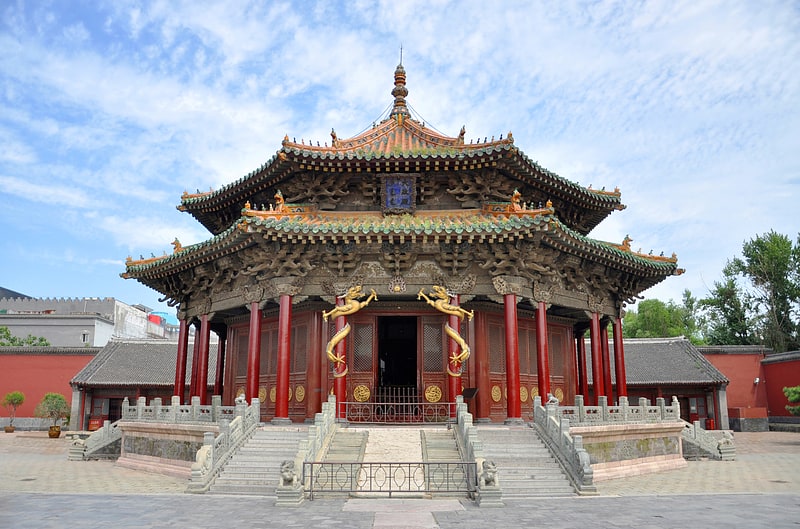
Also known as: 沈阳故宫
Ornate Qing Dynasty royal palace complex. The Mukden Palace, or Shenyang Imperial Palace, was the former imperial palace of the early Manchu-led Qing dynasty. It was built in 1625, and the first three Qing emperors lived there from 1625 to 1644. Since the collapse of imperial rule in China, the palace has been converted to a museum that now lies in the center of Shenyang, Liaoning.[22]
Address: Shenyang Rd, Shenhe District, Shenyang
Memorial of the Huangpu Military Academy, Guangzhou
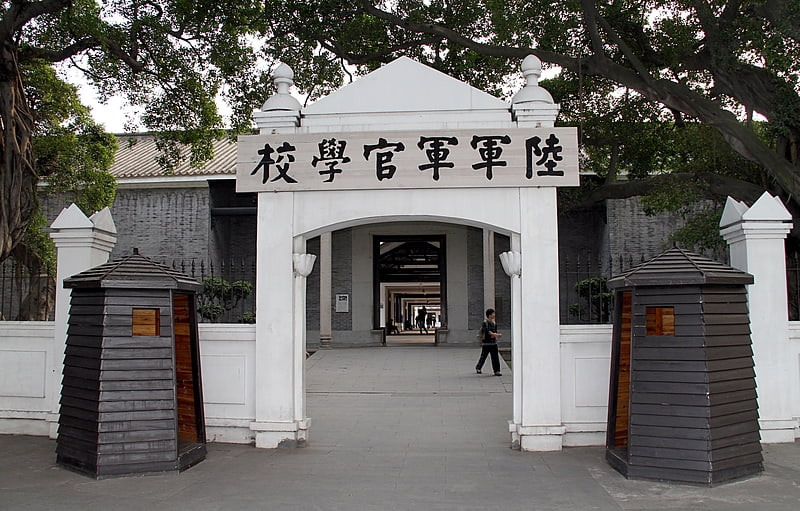
The former site of the Whampoa Military Academy is located in the Huangpu District of Guangzhou, China, on the island of Cheung Chau, formerly the Qing Dynasty Army Primary School and Naval School building.On June 16, 1924, Sun Yat-sen, with the help of Soviet advisers, founded the school to train military cadres Chinese Nationalist Army Officers School, which was later renamed the Republic of China Army Officers School to date.
The school is commonly known as the Whampoa Military Academy because it is located on the island of Cheung Chau in Whampoa. The military academy operated here until the seventh term, then moved to Nanjing in September 1930, and later to Chengdu and Kaohsiung.
Whampoa Military Academy gate above the center of the horizontal plaque on the Tan Yanjin book "Army Officers School" a few big words. At the entrance of the second door hangs "kill the enemy to stop, complete the revolution to turn back" couplet, the right wall of the second door hangs Chiang Kai-shek handwritten school motto "Dear sincerity". Whampoa military school headquarters is a day-shaped two-story brick structure, three roads four, corridors connected to the building. When the military school was founded, in front of the ancestral hall gate of the former Army Primary School, a European-style gate was added. Zhongshan's former residence is the "historical monument showroom", with a floor area of 805 square meters, which was restored in 1952 and was originally the General Taxation Department of the Qing Dynasty. Located in the former residence of Dr. Sun Yat-sen west of the student club is a European-style red building, the auditorium podium in the center and on both sides were hanging Sun Yat-sen statue, the legacy of the Prime Minister, the Chinese Nationalist Party flag, the Republic of China flag and Lin Zexu burning opium, the Boxer Rebellion.
The Tomb of the Fallen Martyrs of the Eastern Expedition is located in Pinggang, southwest of the military academy, covering an area of more than 50,000 square meters. It was built in 1925 by the military government of the Republic of China to commemorate the fallen soldiers who crushed the Chen Jiongming rebels and was completed in June 1926, with the remains of 516 martyrs buried. In front of the cemetery, there is the Memorial Square for the Fallen Martyrs of the Eastern Expedition built in 1928, which is a triumphal arch-style building covered with glazed tiles of national characteristics, with large letters written by Chiang Chung-cheng. In 1936, the East March Martyrs' Memorial Square and the pier were added to the main gate of the cemetery, which is known as the small Huanghuagang. The cemetery was destroyed during the Cultural Revolution and was repaired and restored in 1984. To the south of the campus, there is the Kyo-Shi Pavilion and the Northern Expedition Monument. The monument is more than 7 meters high and was built to commemorate the soldiers who died in the Northern Expedition. To the southwest of the campus, a theater-style club was built with a swimming room on its west side.
At the top of Bagua Hill behind the military academy, there is a 40-meter-high monument to Premier Sun, which was laid in 1928 and completed on September 26, 1930, with a 2.6-meter-high bronze statue of Premier Sun, weighing more than 2,000 pounds. The front of the monument is "Sun Yat-sen Memorial Monument" in six large characters in clerical script, the back is the statue of the Premier, the east is the Premier's legacy, and the west is the Premier's opening speech. The wall where the stairs from the bottom to the top of the mountain are located is decorated with stone, and the four words of the school motto "Dearness and Sincerity" are inlaid on the surface.
In 1937, the Whampoa Army Officers' School Alumni Association used the old site of the Whampoa Military Academy in Guangzhou to found the Whampoa C.C.S. School, which followed the Whampoa Military Academy motto of "Dearness and Sincerity", but composed a new school song. Later, the school was renamed "Guangdong Huangpu Zhongzheng Middle School", "Guangdong Huangpu Middle School", and "Guangzhou Sixth Middle School".
Address: Changzhou Island, Guangzhou
Temple of Confucius, Qufu
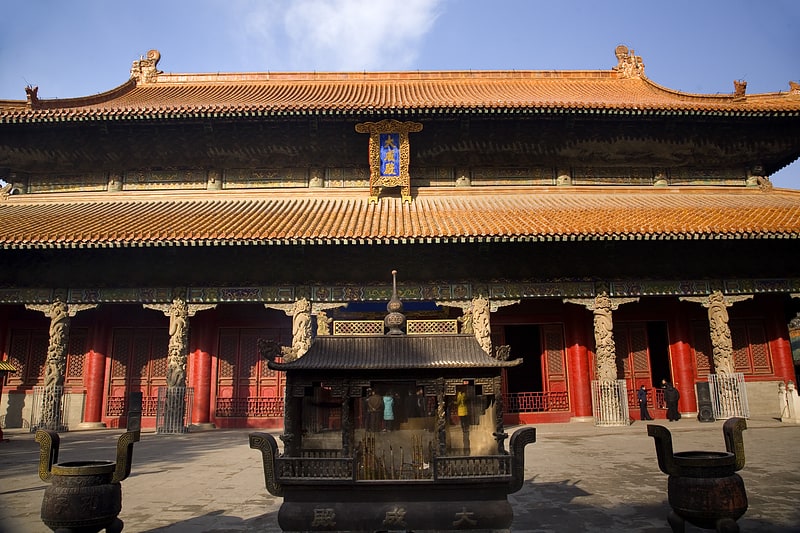
Also known as: 曲阜孔庙
The Temple of Confucius in Qufu, Shandong Province, is the largest and most renowned temple of Confucius in East Asia.
Since 1994, the Temple of Confucius has been part of the UNESCO World Heritage Site "Temple and Cemetery of Confucius and the Kong Family Mansion in Qufu". The two other parts of the site are the nearby Kong Family Mansion, where the main-line descendants of Confucius lived, and the Cemetery of Confucius a few kilometers to the north, where Confucius and many of his descendants have been buried. Those three sites are collectively known in Qufu as San Kong (三孔), i.e. "The Three Confucian ".[23]
Address: Queli Sreet, Qufu
Nanjing Museum, Nanjing
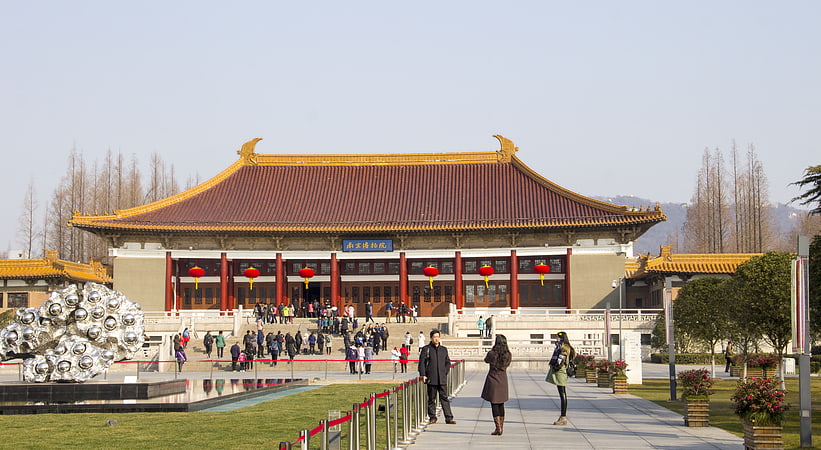
Also known as: 南京博物院
Museum in Nanjing, China. The Nanjing Museum is located in Nanjing, the capital of Jiangsu Province in East China. With an area of 70,000 square metres, it is one of the largest museums in China. The museum has over 400,000 items in its permanent collection, making it one of the largest in China. Especially notable is the museum's enormous collections of Ming and Qing imperial porcelain, which is among the largest in the world.[24]
Address: 321 Zhongshan Rd. (E), 210016 南京市
Master of the Nets Garden, Suzhou
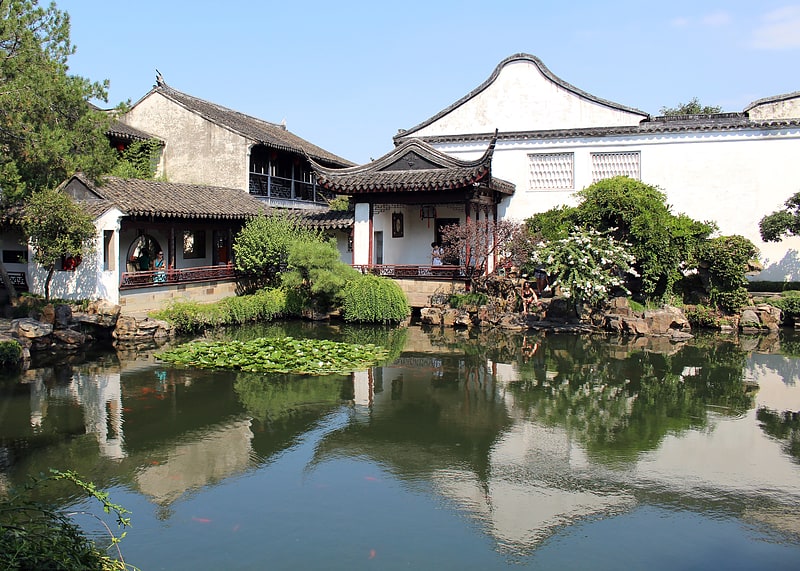
Also known as: 网师园
Historic garden with water and pavilions. The Master of the Nets Garden in Suzhou is among the finest gardens in China. It is recognized with other classical Suzhou gardens as a UNESCO World Heritage Site. The garden demonstrates Chinese garden designers' adept skills for synthesizing art, nature, and architecture to create unique metaphysical masterpieces. The Master of the Nets is particularly regarded among garden connoisseurs for its mastering the techniques of relative dimension, contrast, foil, sequence and depth, and borrowed scenery.[25]
Address: 11 Kuojiatou Alley, Suzhou
Lingering Garden, Suzhou
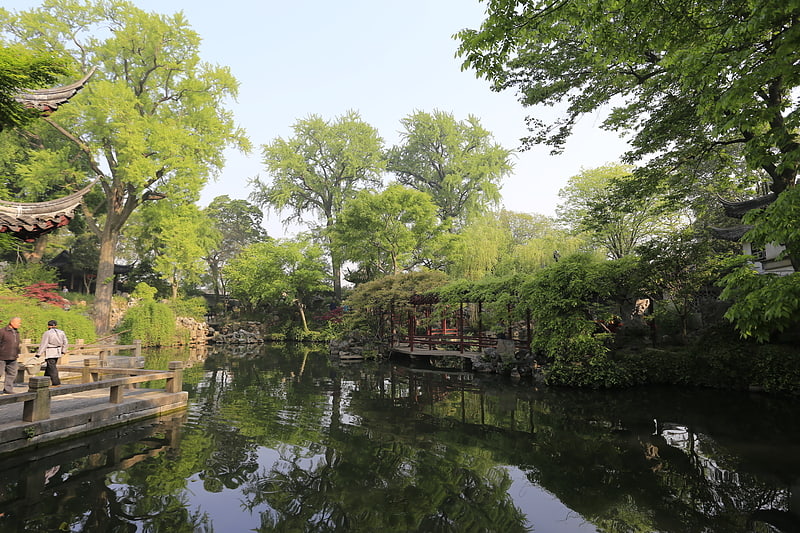
Also known as: 留园
UNESCO-recognized classical garden. Lingering Garden is a renowned classical Chinese garden, dating back to 1593. It is located at 338 Liuyuan Rd. Suzhou, Jiangsu province, China. Since 1997 it has been recognized with seven other Classical Gardens of Suzhou as a UNESCO World Heritage Site. The garden also contains two UNESCO Intangible World Heritage Arts; Pingtan and Guqin music.[26]
Address: 338 Liuyuan Rd, Suzhou
Sacred Heart Cathedral, Guangzhou
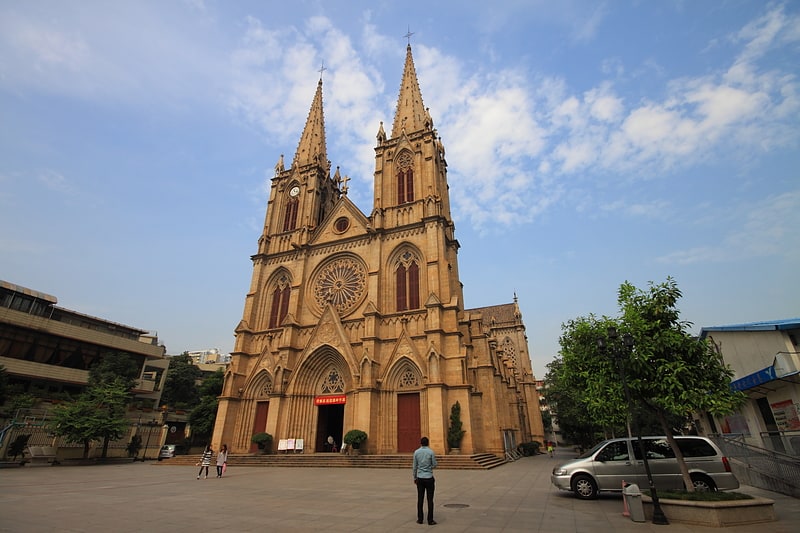
Also known as: 石室圣心大教堂
Gothic-style cathedral completed in 1888. The Sacred Heart Cathedral, properly the Cathedral of the Sacred Heart of Jesus and also known as the Stone House by locals, is a Gothic Revival Roman Catholic cathedral in Guangzhou, China. It is the seat of the Archbishop of Guangzhou. The cathedral is located at 56 Yide Road, on the north bank of the Pearl River at the heart of the old town. It is one of the few cathedrals in the world to be entirely built of granite, including all the walls, pillars, and the twin towers.[27]
Chen Clan Ancestral Hall, Guangzhou
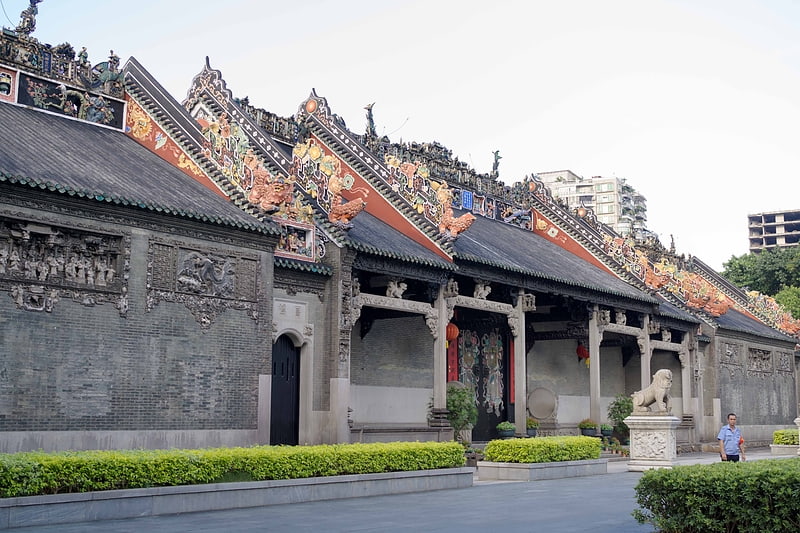
Also known as: 陈家祠
Museum in Guangzhou, China. The Chen Clan Ancestral Hall or Chen Clan Academy is an academic temple in Guangzhou, China, built by the 72 Chen clans for their juniors' accommodation and preparation for the imperial examinations in 1894 in Qing Dynasty. Later it was changed to be the Chen Clan's Industry College, and then middle schools afterward. Now it houses the Guangdong Folk Art Museum.
Located at Zhongshan 7th Road beside the Chen Clan Academy metro station, the Chen Clan Ancestral Hall is a symmetric complex consist of 19 buildings with nine halls and six courtyards. Facing south, the complex forms around a north-south axis. A large collection of southern China art pieces, such as wood carvings and pottery, can be found in the structure. The Chen Clan Ancestral Hall complex exemplifies traditional Chinese architecture and decoration style, and has influenced cultural and architectural developments worldwide. It was added in the list of "Cultural Relics of National Importance under the Protection of the State" in 1988.[28]
Address: Zhongshan 7th Road (中山七路), Guangzhou
Leifeng Pagoda, Hangzhou

Also known as: 雷峰塔
Reconstructed 5-story pagoda. Leifeng Pagoda is a five story tall tower with eight sides, located on Sunset Hill south of the West Lake in Hangzhou, Zhejiang, China. Originally constructed in the year AD 975, it collapsed in 1924 but was rebuilt in 2002. Since then, it has become a popular tourist attraction.[29]
Address: 15 Nanshan Rd., Hangzhou
Sera Monastery, Lhasa
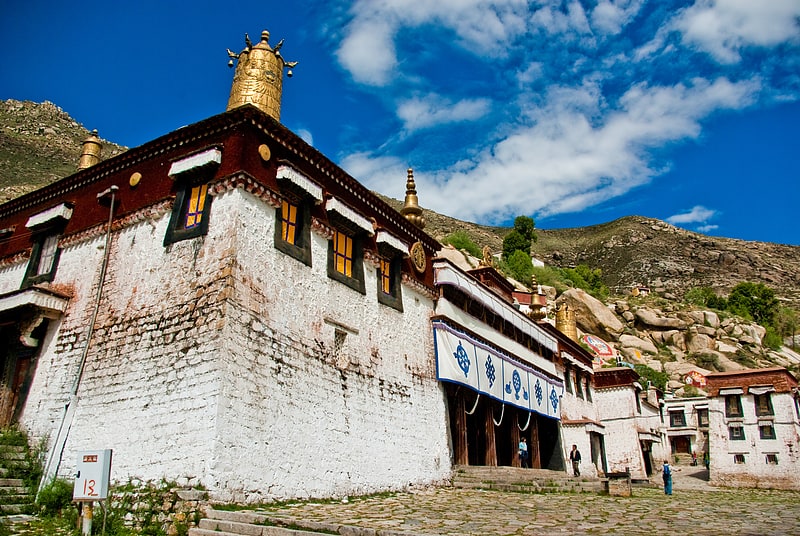
Also known as: 色拉寺
Giant, ancient Tibetan Buddhist complex. Sera Monastery is one of the "great three" Gelug university monasteries of Tibet, located 1.25 miles north of Lhasa and about 5 km north of the Jokhang. The other two are Ganden Monastery and Drepung Monastery. The origin of its name is attributed to a fact that during construction, the hill behind the monastery was covered with blooming wild roses.
The original Sera Monastery is responsible for some 19 hermitages, including four nunneries, which are all located in the foot hills north of Lhasa.
The Sera Monastery, as a complex of structures with the Great Assembly Hall and three colleges, was founded in 1419 by Jamchen Chojey of Sakya Yeshe of Zel Gungtang (1355–1435), a disciple of Je Tsongkhapa. During the 1959 revolt in Lhasa, Sera monastery suffered severe damage, with its colleges destroyed and hundreds of monks killed. After the Dalai Lama took asylum in India, many of the monks of Sera who survived the attack moved to Bylakuppe in Mysore, India. After initial tribulations, they established a parallel Sera Monastery with Sera Me and Sera Je colleges and a Great Assembly Hall on similar lines to the original monastery, with help from the Government of India. There are now 3000 or more monks living in Sera, India and this community has also spread its missionary activities to several countries by establishing Dharma centres, propagating knowledge of Buddhism.
Sera Monastery in Tibet and its counterpart in Mysore, India are noted for their debate sessions.[30]
Address: Wuze Hill , Sera, 850000 Lhasa
Mount Wutong, Shenzhen
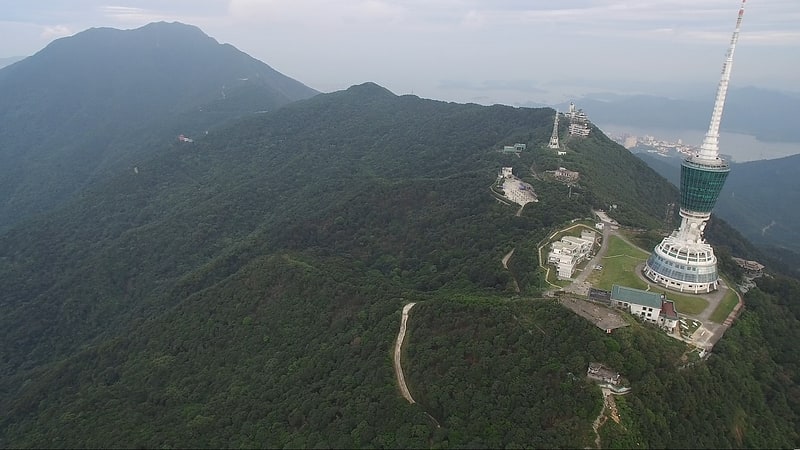
Also known as: 梧桐山
Mountain in China. Wutong Mountain is a mountain located near the border of Luohu and Yantian in Shenzhen, China. At 943.7m, it is the tallest mountain in Shenzhen. The mountain is also source of the Shenzhen River.[31]
Luohu Commercial City, Shenzhen
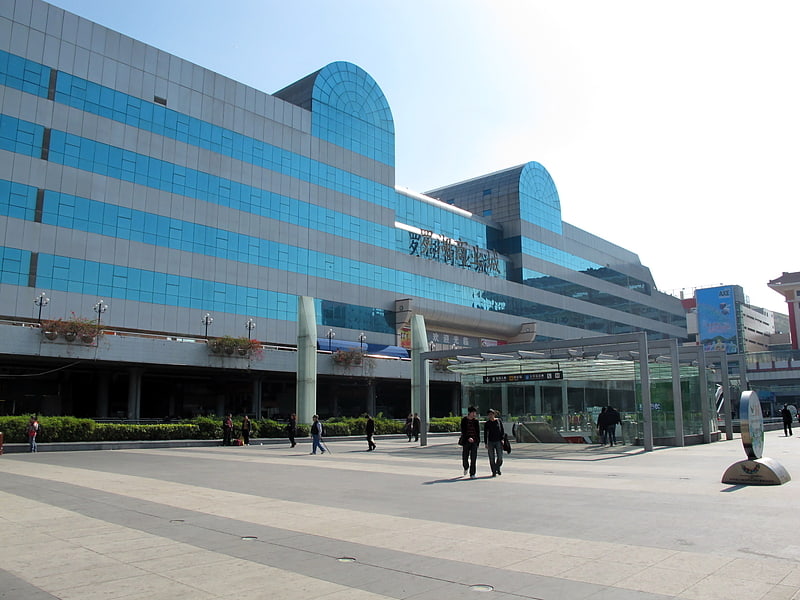
Also known as: 羅湖商業城
Shopping mall. Luohu Commercial City is an enclosed shopping mall located on the Shenzhen side of the Shenzhen River, right outside the entrance/exit to Luohu Immigration Control Point. Also called "Luohu commercial market", it is popular with Hong Kong residents for cheap counterfeit "as good as original" clothes, merchandise and electronics.[32]
Hangzhou Museum, Hangzhou
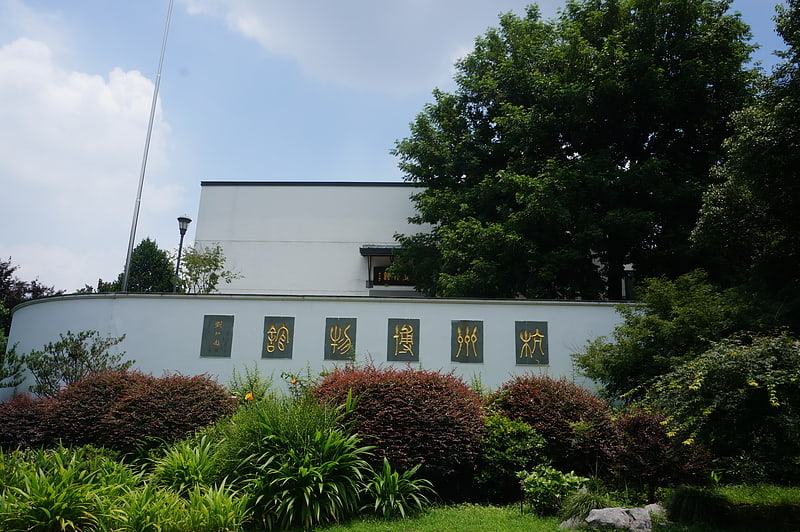
Museum in Hangzhou, China. Hangzhou Museum, formerly "Hangzhou History Museum", is a national first-grade museum in Hangzhou, Zhejiang, China.[33]
Shenzhen Museum, Shenzhen
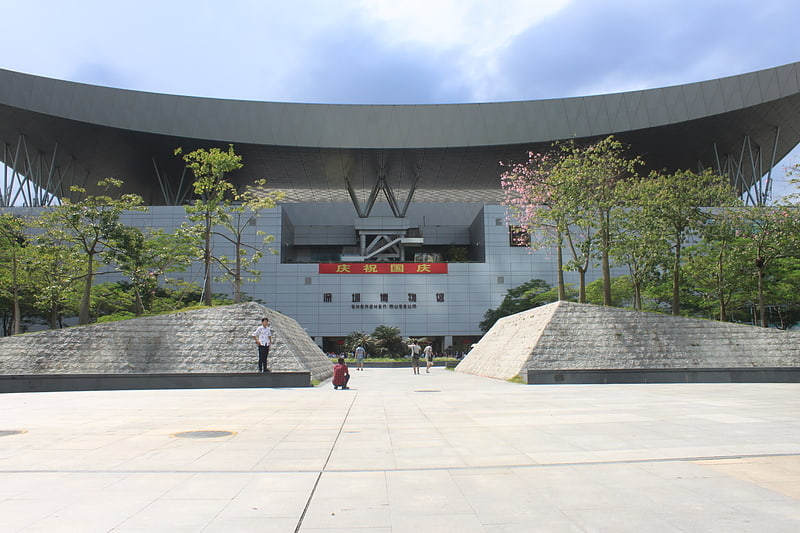
Also known as: 深圳博物馆
Museum in Shenzhen, China. Shenzhen Museum is a multifunctional modern museum in Shenzhen, Guangdong, China. It has a total area of 37,000 square meters, and a building area of 18,000 square meters. The museum was established in 1981, but was not formally opened until 1988. It holds more than 20,000 historical and cultural relics, of which the majority originate within the city.
Exhibition halls that are open include the Shenzhen Museum of History and Folk Culture (历史民俗馆) in Civic Center and the Shenzhen Reform and Opening-up Exhibition Hall (深圳改革开放展览馆) in Futian District and the Dongjiang River Guerrilla Command Headquarters Memorial Museum (东江游击队指挥部旧址纪念馆) in Luohu District. As of 2019 Shenzhen Museum of Ancient Art (古代艺术馆) in Futian District is not open to the public.[34]
Address: Jintian Rd Entrance, Shenzhen Civic Centre, Futian District (福田区市民中心东座), Shenzhen
Chengdu Research Base of Giant Panda Breeding, Chengdu
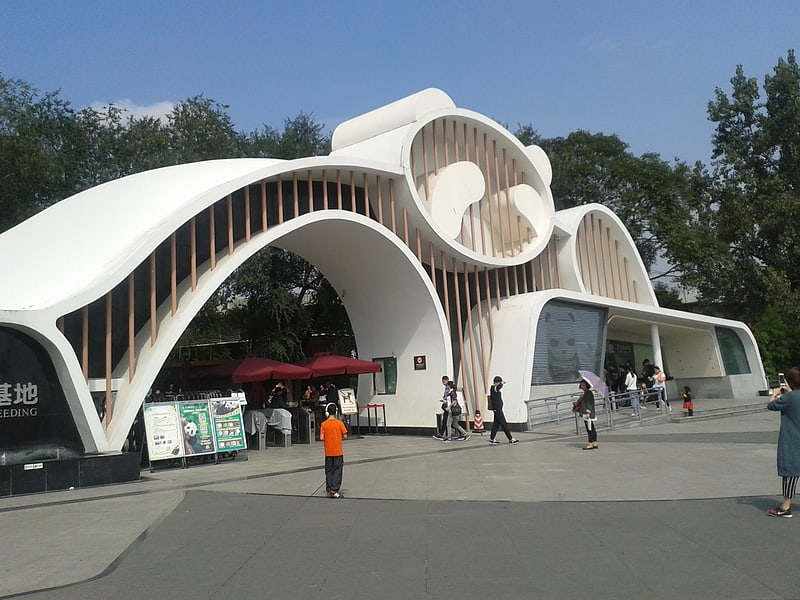
Also known as: 成都大熊猫繁育研究基地
Tourist attraction in Chengdu, China. Chengdu Research Base of Giant Panda Breeding, or simply Chengdu Panda Base, is a non-profit research and breeding facility for giant pandas and other rare animals. It is located in Chengdu, Sichuan, China.
Chengdu Panda Base was founded in 1987. It started with 6 giant pandas that were rescued from the wild. By 2008, it had 124 panda births, and the captive panda population has grown to 83.
Its stated goal is to "be a world-class research facility, conservation education center, and international educational tourism destination."[35]
Yellow Crane Tower, Wuhan

Also known as: 黄鹤楼
Elaborate, reconstructed, 5-story tower. Yellow Crane Tower is a traditional Chinese tower located in Wuhan. The current structure was built in 1981, but the tower has existed in various forms from as early as AD 223. The current Yellow Crane Tower is 51.4 m high and covers an area of 3,219 m2. It is situated on Snake Hill, one kilometer away from the original site, on the banks of the Yangtze River in Wuchang District.[36]
Address: 1 Sheshan, Wuhan
Happy Valley Wuhan, Wuhan
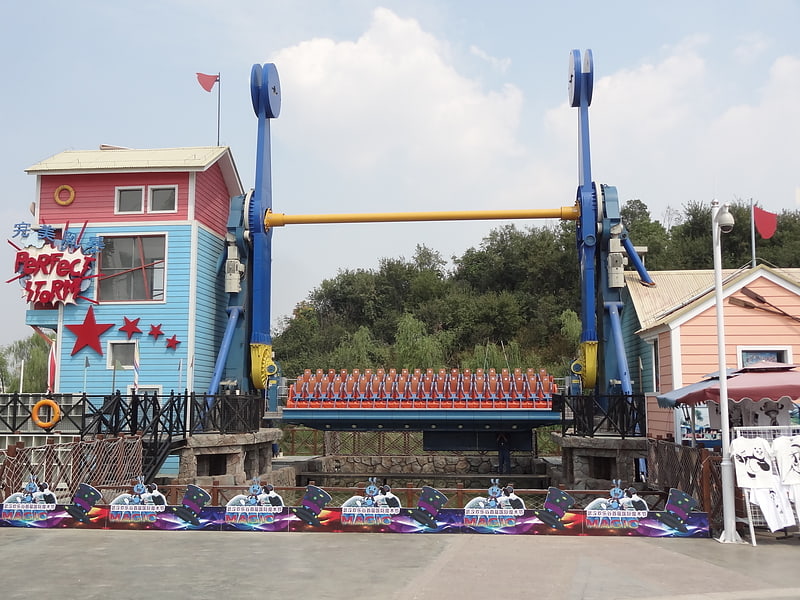
Also known as: 武汉欢乐谷
Theme park in Wuhan, China. Happy Valley Wuhan is a theme park in Hongshan District, Wuhan, Hubei Province, China. Opened on 29 April 2012, it is the fifth installation of the Happy Valley theme park chain.[37]
Address: Donghu Tourism Resort, Wuhan
Cemetery of Confucius, Qufu
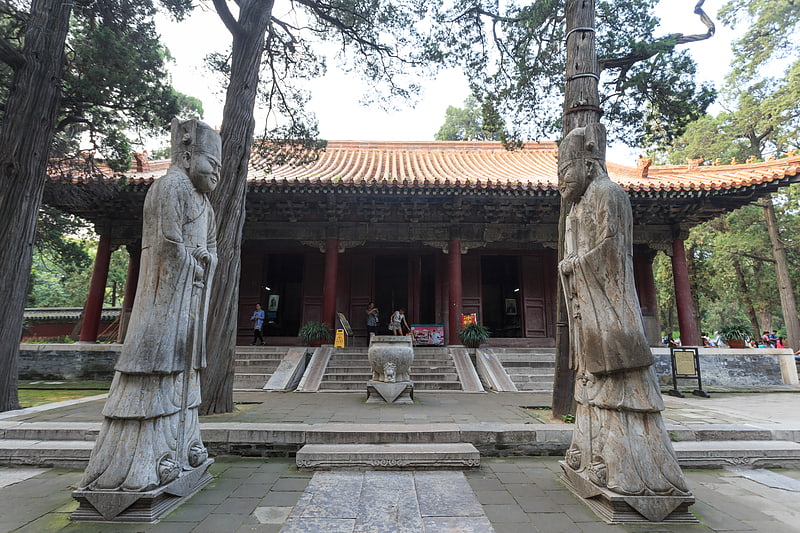
Also known as: 孔林
Cemetery. The Cemetery of Confucius is a cemetery of the Kong clan in Confucius' hometown Qufu in Shandong province. Confucius himself and some of his disciples are buried there, as well as many thousands of his descendants.
Since 1994, the Cemetery of Confucius has been part of the UNESCO World Heritage Site "Temple and Cemetery of Confucius and the Kong Family Mansion in Qufu". The two other components of the site are the Temple of Confucius dedicated to the memory of the philosopher and the Kong Family Mansion, where his descendants lived. The three sites are collectively known in Qufu as San Kong (三孔), i.e. "The Three Confucian ".[38]
Huanan Seafood Wholesale Market, Wuhan
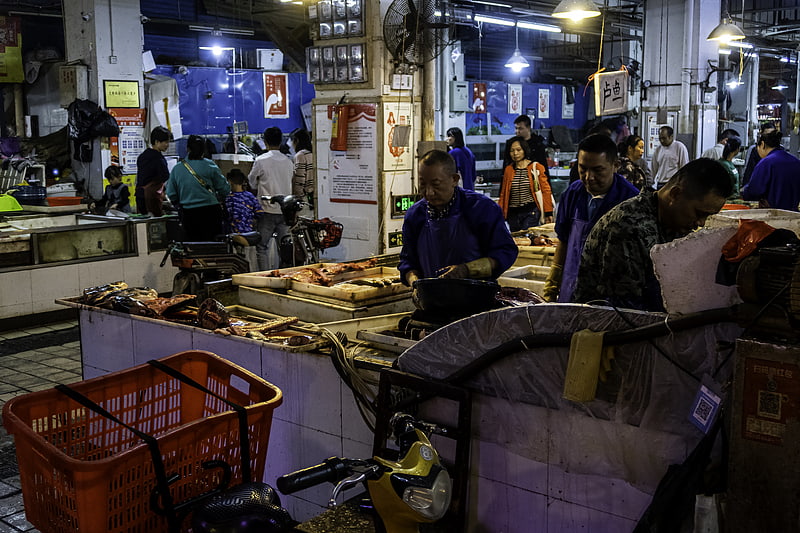
The Wuhan Huanan Seafood Wholesale Market, simply known as the Huanan Seafood Market, was a live animal and seafood market in Jianghan District, Wuhan City, the capital of Hubei Province in Central China.
The market became widely known worldwide after being identified as the 'Ground Zero' site of COVID-19 and the resulting pandemic. The World Health Organization was notified on 31 December 2019 about an outbreak of pneumonia in Wuhan. Of the initial 41 people hospitalized with pneumonia who were officially identified as having laboratory-confirmed SARS-CoV-2 infection by 2 January 2020, two-thirds were exposed to the market. The market was opened on 19 June 2002 and closed permanently on 1 January 2020 for sanitary procedures and disinfection. Thirty-three out of 585 environmental samples obtained from the market indicated evidence of coronavirus disease (COVID-19) outbreak, according to the Chinese Center for Disease Control and Prevention.[39]
Seven-star Cave, Guilin

Seven-star Cave is an extensive limestone cave complex in Seven-star Park, both of which are popular tourist attractions in the city of Guilin in Guangxi Autonomous Region in China. The name derives from the fact the main karst limestone peaks form roughly the same pattern as the stars of the Big Dipper constellation. The earliest exploration of Seven-star Cave dates back to the Tang dynasty, about 1,300 years ago. The name can also be rendered Seven Stars Cave, Cave of Seven Stars, etc.
The cave has a year-round temperature of about 20 Celsius. The maximum ceiling height inside is 27 metres, and the maximum width is 49 metres. A concrete and stone tour path of approximately 1,000 metres runs through the cave between its entrance and exit points. Artificial lighting for walkways and displays is staged throughout, including colored accents, and various formations have been given names such as "A Natural Fresco" and "The Chessboard". During the Japanese invasion of China in World War II, Guilin residents took refuge in the cave complex.
The cave has scheduled tours about once per hour, conducted in Mandarin Chinese, usually with a megaphone irrespective of group size, explaining in detail the origins of various formation names, such as a dragon eating a bear, or a bear catching a tiger. The tour cannot easily be walked independently of groups, since the lights inside the cave are turned off behind the groups as they walk away. Signs are posted in both Chinese and English and takes typically 30–60 minutes.
Like most parks in Guilin, the cave complex maintains an entrance fee, costing 30 RMB beyond the basic park entrance fee of 75 RMB.[40]
Address: 1 七星路, Guilin
South Putuo Temple, Xiamen

Also known as: 南普陀寺
Sprawling Tang Dynasty Buddhist temple. South Putuo or Nanputuo is a famous Buddhist temple founded in the Tang dynasty in the Chinese city of Xiamen. It is so named because it is south of the Buddhist holy site Mount Putuo in Zhejiang Province.[41]
Address: 515 Siming S Rd, 361005 厦门市
Saint Sophia Cathedral, Harbin
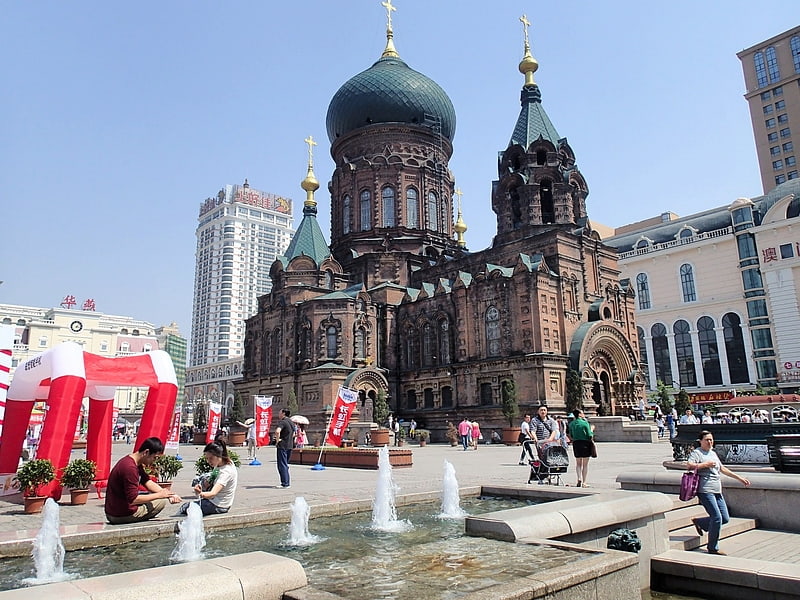
Also known as: 圣索菲亚教堂
Russian Orthodox church, now a museum. The Cathedral of the Holy Wisdom of God or Saint Sophia Cathedral in Harbin is a former Russian Orthodox church located in the central district of Daoli, Harbin City, Heilongjiang, China.[42]
Address: 88 Toulong St, Harbin
Zhao Mausoleum, Shenyang
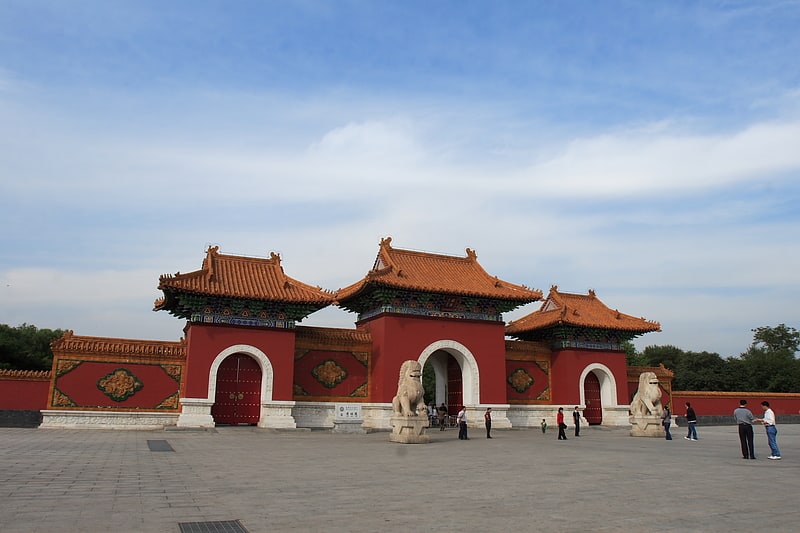
Also known as: 清昭陵
Building in Shenyang, China. Zhaoling, also known as Beiling is the tomb of the first Qing emperor, Hong Taiji, and his Empress Xiaoduanwen.
The tomb is located within Beiling Park, in Huanggu District of the northern urban Shenyang, Liaoning province, and is a popular area attraction. The tomb complex took eight years to build and has a row of animal statues leading to it. The tomb and surrounding park cover an area of 3,300,000 square metres making it the largest of the three imperial tombs north of the great wall. The area around the tomb was originally set aside for imperial use and ordinary people were forbidden entry. This forbidden area was opened to the public in 1928 and now forms Shenyang's Beiling Park.
The Beiling Park has an area of 330 hectares, and contains many historic buildings, pine trees and lakes. In 1927, Government of the Fengtian Province established the park, which includes Zhaoling and surrounding area. West of the tomb are flower gardens and east are several lakes. There is also a Children's Garden within the park.[43]
Shenyang Botanical Garden, Shenyang
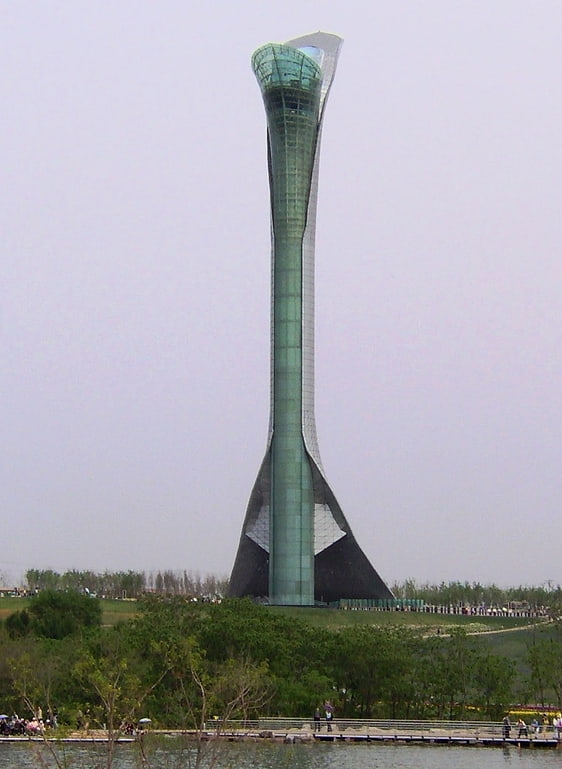
Botanical garden in Shenyang, China. The Shenyang Botanical Garden, also known as "Shenyang World Expo Garden", is located in Qipanshan Tourism Development Zone, in the eastern suburb of Shenyang City, Liaoning, China. It was the site of the 2006 China Shenyang World Horticultural Exposition, and is a 5A Tourist Attraction of China.
The Shenyang Botanical Garden was founded in February 1959.[44]
Qutang Gorge, Chongqing
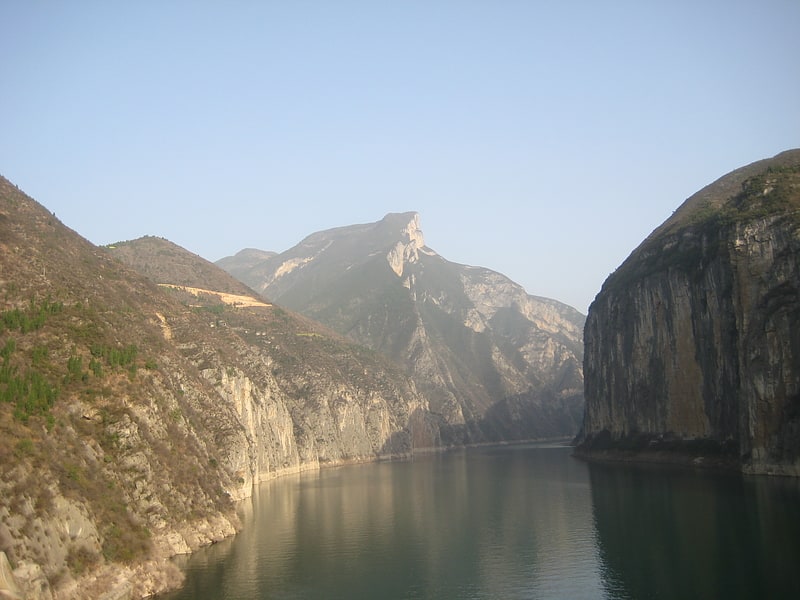
Also known as: 瞿塘峡
The Qutang Gorge is the shortest of China's Three Gorges. Immediately downstream of the ancient village Baidicheng the Yangtze River passes between the Chijia Mountain on the north and the Baiyan Mountain on the south. The point where the river passes between these mountains is called the Kuimen Gate and it is the entrance to the Qutang Gorge - the first of the three Yangtze gorges. The Qutang Gorge is only 8 kilometres long, but it is also the narrowest of the Three Gorges. The widest point measures only 150 metres wide. The mountains on either side reach as high as 1,200 metres. This combination of narrow canyons among high mountains with several switchbacks in only 8 kilometres creates spectacular vistas, and the Qutang Gorge is often considered the most beautiful of all the Three Gorges.
The gorge is part of Fengjie County of the Chongqing Municipality.[45]
Address: Baidi Cheng, 404600 Fengjie County
Du Fu Thatched Cottage, Chengdu

Also known as: 杜甫草堂
Former residence of Tang Dynasty poet. Du Fu Thatched Cottage is a 24-acre park and museum in honour of the Tang dynasty poet Du Fu at the western outskirts of Chengdu, adjacent to the Huanhua Xi. In 1961 the Chinese government made the cottage a National Heritage site.[46]
Baotu Spring, Jinan
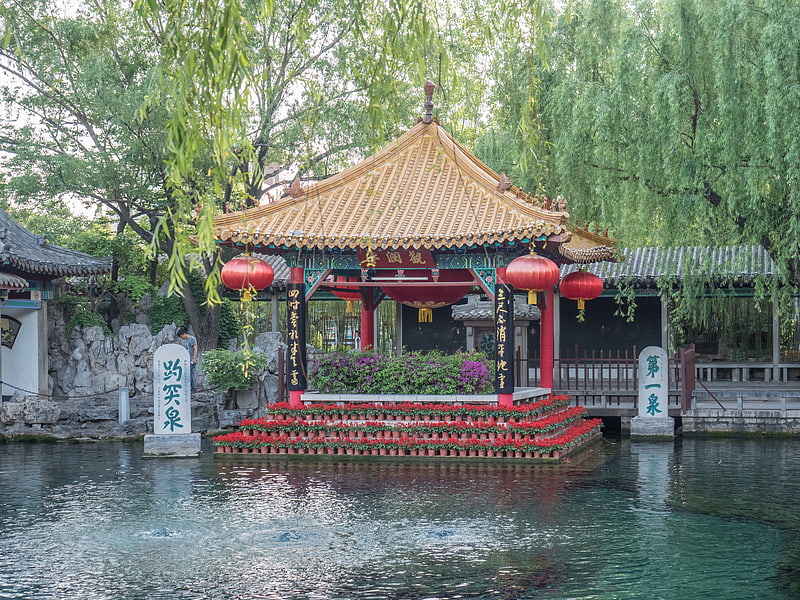
Also known as: 趵突泉
National park in Jinan, China. The Baotu Spring is a culturally significant artesian karst spring located in the city of Jinan, Shandong, China. It is mentioned in the Spring and Autumn Annals, one of the Five Classics of Chinese literature, and was declared the "Number One Spring under the Heaven" by the Qianlong Emperor in the Qing dynasty.
The Baotu Spring is the most renowned among the more than 70 named artesian springs in the downtown area of the city of Jinan. The water of all these springs originates from an Ordovician karst aquifer under the city. As the terrain around Jinan slopes from the south down to the north, the recharge area for the aquifer is located in the mountainous area to the south of the city. The recharge area of the springs covers 1,500 square kilometres, out of which 550 km2 provide direct recharge and 950 km2 indirect recharge.
Altogether, the springs fed by the aquifer have a discharge of about 300,000-350,000 cubic metres per day. Since the 1970s, the springs have stopped flowing several times because too much water has been taken out from the aquifer for human consumption.
The Baotu Spring is part of a cluster of about 20 named springs. Water age estimates suggest that its water originates from shallow circulation.
The spring pool of the Baotu Spring is fed by an underwater limestone water through three outlets; the volume of the water coming out of the spring can reach peak values up to 1.6 cubic metres per second. The water jets from the spring are said to have reached highs up to 26 metres. The water temperature remains constant of 18 degree Celsius through the entire year.[47]
Address: 1 Baotuquan South Rd, Lixia District, Jinan
Tianyi Ge, Ningbo
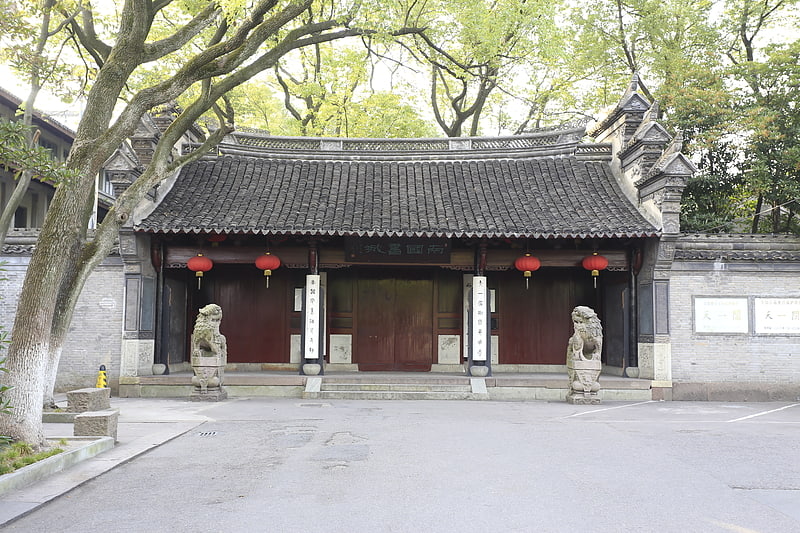
Also known as: 天一阁
Tourist attraction in Ningbo. The Tianyi Ge, translated as Tianyi Pavilion or Tianyi Chamber, is a library and garden located in Ningbo, Zhejiang Province, China. It is the oldest existing library in China. Founded in 1561 by Fan Qin during the Ming dynasty. In its heyday, it boasted a collection of 70,000 volume of antique books.
The name Tian Yi refers to the concept of cosmic unity first described in a Han dynasty commentary to the Book of Changes. In Chinese alchemy Tianyi is linked to the element of water, thus it was believed by providing a watery name would protect the library against fire damage.
The Qianlong Emperor of the Qing dynasty visited Tianyi Ge, and ordered officials to draw schematics of Tianyi Ge's building plan and book cases as prototype to build several imperial libraries including Wenyuan Ge in the Forbidden City, and Wenjin Ge in the Chengde Mountain Resort to house the Siku Quanshu encyclopedia.
After the Second Opium War, the British took many books from the libraries collection of geography and history texts. These losses were followed by further thefts by local thieves. By 1940, the collection dwindled to less than 20,000 volumes. After the founding of the People's Republic of China, due to governmental effort and donations by private collectors, the collection recovered somewhat to about 30,000 volumes, mostly rare antique Ming dynasty printed and hand copied volumes.
In 1982, Tianyi Ge was established by the Chinese authorities as a National Heritage Site. The Qin Family Drama Stage is also located in the complex.
The walls were specially constructed to prevent fire.[48]
Address: 39 Tianyi St | 天一街39号, 315010 宁波
Jinsha site, Chengdu
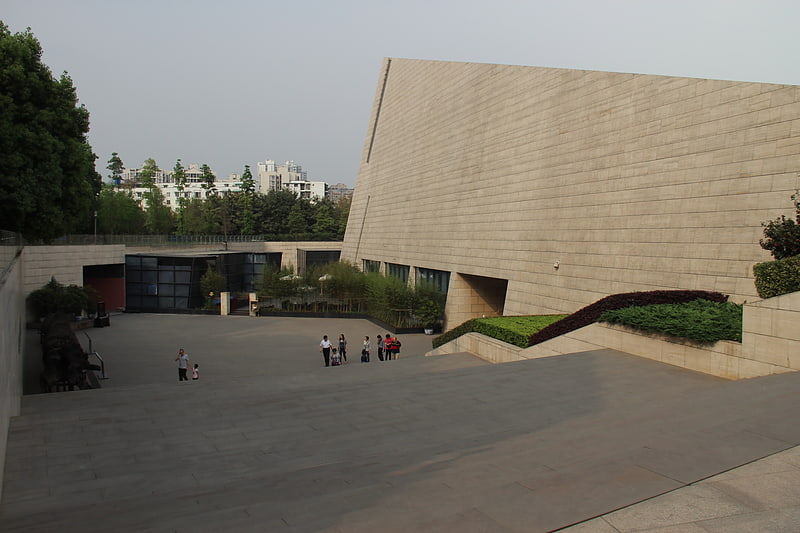
Also known as: 金沙遗址
Jinsha is a Chinese archaeological site located in the Qingyang District of Chengdu, the capital of China's Sichuan Province. Along with Sanxingdui, the site is the first major discovery in China during the 21st century. It is listed on the UNESCO World Cultural Heritage Tentative List and Major Sites Protected at the National Level. The Chinese Internet Information Centre ranked Jinsha 5th on the Top 10 Archaeological Discoveries in 2001.
In 2007, the Jinsha Museum was constructed to display the artefacts and features found. This includes the gold sunbird, smiling gold mask and the kneeling stone figures. The gold sunbird artefact is a national symbol of China according to the State Administration of Cultural Heritage. Jinsha is organised into different archaeological localities such as Mei Yuan, Lan Yuan and Tiyu Gongyuan.
After the decline of Sanxingdui, Jinsha emerged as the capital of the Shu state in the Shang or Western Zhou dynasty. It disappeared between 500BCE to 200BCE due to political revolution, earthquakes and or flooding.
In 2013, History Channel Asia produced a one-hour English language documentary called The Lost City at Jinsha. It was co-produced with China International Communication Centre (CICC). Dr Agnes Hsu, a Chinese American archaeologist, hosted the episode. The episode is part of the documentary series called 'Mysteries of China'.[49]